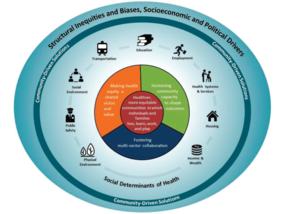
As we kick-off the new calendar year, the VA Office of Health Equity (OHE) is delighted
to share our efforts during the last fiscal year in championing health equity
for Veterans. We continue to make great strides in furthering Veteran health equity through partnerships and direct action on behalf of our nation's heroes. Thank you for continuing to engage and make Veteran health equity your business in 2018.
- OHE published the National Veterans Health Equity Report,
which is now available for downloading onto your mobile device via an ePUB
version via the OHE website and the following online bookstores: Apple,
Barnes and Nobles, and Google.
- OHE released Virtual Training Modules to assist clinicians,
non-clinicians, Veterans, and stakeholders in understanding the importance
of assessing, and increasing competency, of health equity issues for
Veterans of all races and ethnicities.
-
The main paper from the Transgender Veterans Protocol was one of
the most downloaded and cited article from the journal publisher since
publication.
-
Focus on Health Equity and Action Cyberseminars
reached over 2,300 registrants and over 700 attendees to the seminars.
These data do not include archive accesses, which all registrants receive
when archive is available.
-
OHE website had over 15,000 total page
views and over 12,000 unique page views.
-
Twenty bulletins were sent out via the OHE listserv reaching over 380,000 total
recipients.
-
OHE Chief Officer, Uchenna S. Uchendu, MD, received the
Congressional Black Caucus (CBC) Veterans Braintrust
Award for her service to Veterans.
- OHE Program Analyst, Kenneth T. Jones, PhD was selected
for the inaugural Leaders for Health Equity Fellowship Program
sponsored by the George Washington University Health Workforce Institute.
Some progress is being made to advance health equity for
Veterans. Unfortunately, but consistent with the general U.S. population,
health disparities and inequities continue to be documented for Veterans regardless
of where they receive their care. The VA Office of Health Equity (OHE) was established
in the VHA in 2012 as a national program office and given the immediate charge
to map VA’s pursuit of Veteran health equity. February’s Focus on Health Equity
and Action Cyberseminar will review VA efforts over the last 5 years to advance
health equity for Veterans since the establishment of OHE. Presenters will
discuss VA’s progress in implementing VA’s strategic plan to advance health
equity; OHE supported activities in advancing research, partnerships and tools;
and future actions to ensure all Veterans have access and receive high quality,
timely, and equitable care.
Pursuing Health Equity
for Veterans with a Dedicated National Program Office—Five Years in Review
Thursday, February 22, 2018
3:00
– 4:00 PM EST
Learning
Objectives
-
Describe
the development of a national program in the VA to advance Veteran health
equity;
- Identify
strategic goals and metrics of the VA Health Equity Action Plan related to
leadership, research, and partnerships to advance health equity; and
- Discuss
future research, quality improvement efforts, and other actions to reduce
and/or eliminate Veteran health disparities.
Confirmed
Presenters
-
Uchenna S. Uchendu, MD
Chief Officer, Office of Health Equity, VA Central Office, Washington, DC
-
Kenneth T. Jones,
PhD
Program Analyst, Office of Health Equity, VA Central Office, Washington,
DC
The VA Office of Health Equity is pleased to share recent health equity
research and resources from VA researchers and partnering organizations.
The
Association Between Neighborhood Environment and Mortality: Results from a
National Study of Veterans

Background: As
the largest integrated US health system, the Veterans Health Administration
(VHA) provides unique national data to expand knowledge about the association
between neighborhood socioeconomic status (NSES) and health. Although living in
areas of lower NSES has been associated with higher mortality, previous studies
have been limited to higher-income, less diverse populations than those who
receive VHA care.
Design:
One-year
observational cohort of veterans who were alive on December 31, 2011. Data on
individual veterans (vital status, and clinical and demographic
characteristics) were abstracted from the VHA Corporate Data Warehouse. Census
tract information was obtained from the US Census Bureau American Community
Survey. Logistic regression was used to model the association between NSES
deciles and all-cause mortality during 2012, adjusting for individual-level
income and demographics, and accounting for spatial autocorrelation.
Conclusions: Lower
neighborhood SES is associated with all-cause mortality among veterans after
adjusting for individual-level socioeconomic characteristics. NSES should be
considered in risk adjustment models for veteran mortality, and may need to be
incorporated into strategies aimed at improving veteran health.
Nelson, K., Schwartz, G., Hernandez, S., Simonetti, J.,
Curtis, I., & Fihn, S. D. (2017). The Association Between Neighborhood
Environment and Mortality: Results from a National Study of Veterans. Journal
of General Internal Medicine, 32(4), 416-422.
|
Communities
in Action: Pathways to Health Equity

Background: In
the United States, some populations suffer from far greater disparities in
health than others. Those disparities are caused not only by fundamental
differences in health status across segments of the population, but also
because of inequities in factors that impact health status, so-called
determinants of health.
Only part of an individual’s health status depends on his
or her behavior and choice; community-wide problems like poverty, unemployment,
poor education, inadequate housing, poor public transportation, interpersonal
violence, and decaying neighborhoods also contribute to health inequities, as
well as the historic and ongoing interplay of structures, policies, and norms
that shape lives. When these factors are not optimal in a community, it does
not mean they are intractable: such inequities can be mitigated by social
policies that can shape health in powerful ways.
Communities in Action: Pathways to Health Equity seeks to
delineate the causes of and the solutions to health inequities in the United
States. This report focuses on what communities can do to promote health
equity, what actions are needed by the many and varied stakeholders that are
part of communities or support them, as well as the root causes and structural
barriers that need to be overcome.
National Academies of Sciences, Engineering, and Medicine. (2017).
Communities in Action: Pathways to Health Equity. Washington, DC: The National
Academies Press. https://doi.org/10.17226/24624.
Photo Caption: A conceptual model for community-based
solutions to promote health equity. Informed by the Robert Wood Johnson
Foundation (RWJF) Culture of Health Action Framework and the Prevention
Institute’s Systems Framework to Achieve an Equitable Culture of Health.
|
Racial/Ethnic
Health Disparities Among Rural Adults — United States, 2012–2015

Problem/Condition: Rural
communities often have worse health outcomes, have less access to care, and are
less diverse than urban communities. Much of the research on rural health
disparities examines disparities between rural and urban communities, with
fewer studies on disparities within rural communities. This report provides an
overview of racial/ethnic health disparities for selected indicators in rural
areas of the United States.
Public Health Action: Stratifying
data by different demographics, using community health needs assessments, and
adopting and implementing the National Culturally and Linguistically
Appropriate Services Standards can help rural communities identify disparities
and develop effective initiatives to eliminate them, which aligns with a Healthy
People 2020 overarching goal: achieving health equity.
James, C. V. (2017). Racial/Ethnic Health Disparities Among
Rural Adults—United States, 2012–2015. MMWR. Surveillance Summaries, 66.
|
|